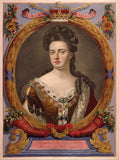
The Jacobite Rebellion was a failed attempt that took place over a number of years to overthrow the British throne and restore power to the Stuart dynasty. The name came from supporters of ousted Stuart king, James II. By 1745 and the recapturing of Carlisle – a town in northern England – the Jacobite army was fighting to place James II’s grandson, Charles Edward Stuart, on the throne, which would restore the Stuart line, which had previously been replaced by the Hanoverians. Charles Edward Stuart became better known as Bonnie Prince Charlie.
Discover the medallion: 1731 Prince Charles Medallion
To begin at the beginning

The roots of the failed Jacobite Rebellion began in 1603 when James I ascended the English throne as the first Stuart king. He was already king James VI of Scotland and added England and Ireland to his kingdom after Elizabeth I died childless. James I quickly turned his attention away from his homeland as he worked to unite his three realms. Many people in Scotland felt bitter that their king had appeared to abandon his Scottish ties.
Decades passed and in 1685 James II took the throne after the death of his brother, Charles II. He faced rebellion led by Charles II’s illegitimate son and worked to promote Roman Catholicism in England, which angered many. A group of Protestant nobles, supported by Parliament, overthrew James II just three years later. He fled abroad and the Protestant William of Orange and his wife, Mary (who was also James II’s Protestant daughter), were crowned joint monarchs in his place.
Discover the medallions:
1689 William & Mary Coronation Medallion by G Hautsch
1689 William & Mary Coronation Medallion by R Arondeaux
1689 William & Mary Coronation Medallion by J Roettier

James II attempted to raise an army to reclaim power, but was defeated by William of Orange at the Battle of the Boyne in 1701.

Queen Anne followed William and Mary. She oversaw the Acts of Union in 1707 which combined England and Scotland fully into one country with one monarch and Parliament.
Discover the medallions:
Condition: EF
1707 Queen Anne - Union of England & Scotland Medallion by J Croker
Condition: NEF
1707 Queen Anne - Union of England & Scotland Medallion by J Croker
All power transferred to London. When Anne died, the crown was supposed to pass to Sophia of the Palatinate (now modern-day Germany), however she died shortly before Anne. Sophia’s son, George I, became the country’s first Hanoverian king and ended the Stuarts’ reign.

In England, Scotland and across the Channel in France, there were many who were unhappy about the arrival of the new Hanoverian monarch. He couldn’t speak any English. In 1715, the Scottish Earl of Mar led a Jacobite rebellion to overthrow George I. He and his followers became known as the ‘Fifteen’. Mar was joined in his endeavours by James II’s son, James Francis Edward Stuart who was living in France. He joined the fight in Scotland; however, the Jacobites were defeated in Preston as they attempted to march to London. Many were tried for treason and executed. James Francis Edward Stuart became known as the ‘Old Pretender’
Discover the medallion: 1721 James III (Elder Pretender) Medallion
Enter Bonnie Prince Charlie

So, we arrive at the 1745 recapturing of Carlisle by the Jacobite army. It was regathering traction under the leadership of ‘Young Pretender’, Bonnie Prince Charlie – the ‘Old Pretender’s eldest son. Bonnie Prince Charlie decided that the time was right to plot another invasion of Great Britain and reclaim the throne for the Stuart cause. By September 1745, his army had marched to Edinburgh, where the ‘Old Pretender’ was declared James VIII of Scotland. Here, Bonnie Prince Charlie planned his invasion to London, aided by his supporters.
Discover the medallion: 1745 Young pretender Medallion
That invasion began in earnest in November 1745, when the Jacobite army reached Carlisle in northern England and recaptured it. Bonnie Prince Charlie laid siege to it, gathering arms, ammunition, horses and supplies for the arduous march south.
Taking a turn for the worse
By the time the Jacobite army had reached Derby, it was faced with increased resistance. Two armies were converging on the battleground from different directions. Furthermore, the Duke of Cumberland and his army had landed at Edinburgh and were also marching on the rebels. Sensing defeat, Bonnie Prince Charlie fled back to Scotland to regroup. The English armies aggressively pursued him. The Jacobite rebellion was eventually crushed and the army defeated, making their final stand at Culloden Moor near Inverness in April 1746. Bonnie Prince Charlie escaped and evaded capture by hiding in the Scottish highlands. This feat is immortalised in in the folksong ‘Skye Boat Song’. He eventually sailed to France and died in Rome in 1788.
Discover the medallion: 1746 Battle of Culloden Medallion
Jacobite medallion
A Jacobite medallion, cast to commemorate the recapturing of Carlisle and the subsequent retreat back to Scotland by Bonnie Prince Charlie and his army is available to purchase from the Historical Medallions website. The 1745 Carlisle Recaptured: Jacobite rebels retreat to Scotland historical medallion by A. Kirk and J. Kirk is made in silver and has a diameter of 35 mm. One side depicts the Duke of Cumberland on a horse, while the other bears a picture of Anglia receiving an olive branch from the duke.
Discover the medallion: 1745 Carlisle Recaptured Medallion

